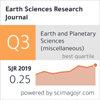Influence of metal roadway supports on transient electromagnetic detection in mines
IF 0.5
4区 地球科学
Q4 GEOSCIENCES, MULTIDISCIPLINARY
引用次数: 0
Abstract
How to cite item Yaoning L., Shucai L., Maofei L., Xinming L., Weihong G. (2021). Influence of Metal Roadway Supports on Transient Electromagnetic Detection in Mines. Earth Sciences Research Journal, 25(1), 109-114. DOI: https://doi.org/10.15446/ esrj.v25n1.80156 To study the influence of metal supports in roadways on the detection of mines using the transient electromagnetic method, authors treated metal supports including anchor nets as a thin metal layer. According to the finite differences principle, the characteristics of the full-space transient electromagnetic response under the thin metal layer’s influence were calculated using a non-uniform grid. The thin metal layer's presence slowed the electromagnetic field’s diffusion rate and hindered the overall diffusion. The transient electromagnetic response curve observed under the thin metal layer’s influence was higher than that without the supports. Thicker metal layers resulted in higher early response values and slower decay rates. The decay rate increased as a function of time, gradually approaching that of the curve without metal supports. The simulation of the transient electromagnetic response to the model of water-containing lowresistance structures showed that the metal roadway support reduced the sensitivity of the transient electromagnetic method and weakened its response to low-resistance anomalies. ABSTRACT Influence of metal roadway supports on transient electromagnetic detection in mines金属巷道支架对矿井瞬变电磁探测的影响
李耀宁,李树才,李茂飞,李新明,郭卫红(2021)。金属巷道支护对矿井瞬变电磁探测的影响地球科学研究,25(1),109-114。为了研究巷道中金属支架对瞬变电磁法探测矿山的影响,作者将包括锚网在内的金属支架视为一薄金属层。根据有限差分原理,采用非均匀网格计算了薄金属层影响下的全空间瞬变电磁响应特性。金属薄层的存在减缓了电磁场的扩散速度,阻碍了整体扩散。金属薄层影响下的瞬变电磁响应曲线高于无支撑时的瞬变电磁响应曲线。较厚的金属层导致较高的早期响应值和较慢的衰减速率。衰减率随时间增加,逐渐接近无金属支撑曲线的衰减率。对含水低阻结构模型的瞬变电磁响应模拟表明,金属巷道支护降低了瞬变电磁法的灵敏度,减弱了其对低阻异常的响应。金属巷道支护对矿井瞬变电磁探测的影响
本文章由计算机程序翻译,如有差异,请以英文原文为准。
求助全文
约1分钟内获得全文
求助全文
来源期刊

Earth Sciences Research Journal
地学-地球科学综合
CiteScore
1.50
自引率
0.00%
发文量
0
审稿时长
>12 weeks
期刊介绍:
ESRJ publishes the results from technical and scientific research on various disciplines of Earth Sciences and its interactions with several engineering applications.
Works will only be considered if not previously published anywhere else. Manuscripts must contain information derived from scientific research projects or technical developments. The ideas expressed by publishing in ESRJ are the sole responsibility of the authors.
We gladly consider manuscripts in the following subject areas:
-Geophysics: Seismology, Seismic Prospecting, Gravimetric, Magnetic and Electrical methods.
-Geology: Volcanology, Tectonics, Neotectonics, Geomorphology, Geochemistry, Geothermal Energy, ---Glaciology, Ore Geology, Environmental Geology, Geological Hazards.
-Geodesy: Geodynamics, GPS measurements applied to geological and geophysical problems.
-Basic Sciences and Computer Science applied to Geology and Geophysics.
-Meteorology and Atmospheric Sciences.
-Oceanography.
-Planetary Sciences.
-Engineering: Earthquake Engineering and Seismology Engineering, Geological Engineering, Geotechnics.
 求助内容:
求助内容: 应助结果提醒方式:
应助结果提醒方式:


